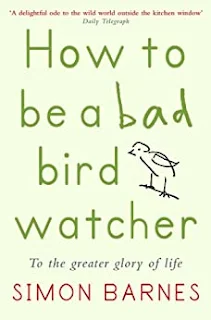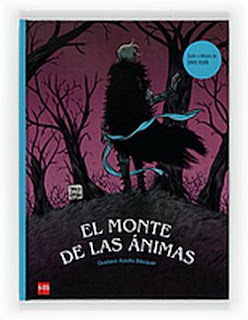HOW TO BE A BAD BIRDWATCHER
Previous posts have covered topics such as physics or mathematics. For the awe and wonder they have inspired, it just seems to follow we should turn our attention now to the natural world. In what very well may be must last post for this academic course, I would like to speak very briefly about a lovely little book titled How to Be a Bad Birdwatcher by Simon Barnes.
The author makes a case for the little act of watching birds with curiosity in our everyday life and what comes from that, becoming, not a professional ornithologist by any means, but a bad birdwatcher. It is easy to understand the source of our fascination for them. Nonetheless, leaving flight aside, we have lots of things in common with them. Moreover, interacting with feathery creatures through observation in the wild is much more interesting and rewarding than with other species. To kick-start your curiosity, I would like to leave an excellent resource that contains the birdsong of the most common species we can find around us. More importantly, here you can find the apps some students and teachers from our school created for species found in our area and surroundings.
After reading this book, I have set myself to make birding a new hobby of mine. I feel incredibly fortunate to live where we live, since Galiza is an area with tremendous possibilities for watching birds, something that should give us a lot to think about. If we were to think of survival as a mathematical equation, biodiversity is the whole array of solutions for this complex problem of life and death, giving us 'endless forms most beautiful' as Charles Darwin put it in the final sentence in On the Origin of Species.
As you probably know by now, I always like to make connections to English literature. Funnily enough, there is a poem that runs as a thread through this book, The Windhover, by Gerard Manley Hopkins. This sonnet manages to condense the sense of marvel towards nature and, in particular, towards an incredible creature: the kestrel. If you are interested in the poem, you can find further information in this link. I cannot resist but pasting the poem here and a short clip showing a common kestrel hovering in the wind, wishing you for this summer the same joy I experience in discovering new things.
I caught this morning morning's minion, king-dom of daylight's dauphin, dapple-dawn-drawn Falcon, in his ridingOf the rolling level underneath him steady air, and stridingHigh there, how he rung upon the rein of a wimpling wingIn his ecstasy! then off, off forth on swing,As a skate's heel sweeps smooth on a bow-bend: the hurl and glidingRebuffed the big wind. My heart in hidingStirred for a bird, – the achieve of, the mastery of the thing!Brute beauty and valour and act, oh, air, pride, plume, hereBuckle! AND the fire that breaks from thee then, a billionTimes told lovelier, more dangerous, O my chevalier!No wonder of it: shéer plód makes plough down sillionShine, and blue-bleak embers, ah my dear,Fall, gall themselves, and gash gold-vermilion.
___________________________________________________________________________________
En publicacións
anteriores temos tratado cuestións de física ou matemáticas. Esa mesma sensación
de abraio que poden inspirar tornarémola hoxe ao mundo natural. No que moi probablemente
sexa o meu último post para este curso, gustaríame falarvos dun libriño
magnífico titulado How to Be a Bad
Birdwatcher de Simon Barnes.
No libro, o autor
desenvolve unha gran defensa do simple acto de observar paxaros con curiosidade
comezando polo noso día a día e o que se sigue disto, convertíndonos, non en
ornitólogos profesionais nin moito menos, senón en maos observadores de aves. É moi sinxelo comprender a orixe da nosa
fascinación por eles. Porén, deixando a un lado a súa capacidade para voar,
temos moito en común con eles como, por exemplo, na nosa maneira de
relacionarnos cos nosos conxéneres nalgúns aspectos. Ademais, interactuar con
estas criaturas plumíferas por medio da súa observación no medio natural ofrece
moitas máis recompensas e interese que con outras especies. Para fomentar a
vosa curiosidade, déixovos un recurso excelente que contén cantos das aves máis
comúns entre nós. Máis importante aínda é estoutra páxina, onde teredes acceso a app en versión multilingüe desenvolvida por compañeiros e profesores do centro.
Despois de ler o
libro, téñome proposto facer da observación de aves unha nova afección. Síntome
moi afortunado de vivir onde vivimos, xa que Galiza é un país con tremendas
posibilidades para ver paxaros de cerca, algo que nos debería dar moito que reflexionar.
De feito, se pensamos na supervivencia como unha ecuación matemática, a
biodiversidade sería o conxunto de solucións para este complexo problema de
vida ou morte, dándonos as «máis fermosas e infinitas formas», tal e como
menciona Charles Darwin na frase final d’A
orixe das especies.
Como xa vos
teredes decatado, sempre intento establecer conexións coa literatura inglesa.
Curiosamente, o autor emprega un poema como unha especie de fío condutor no
libro, The Windhover, de Gerard
Manley Hopkins. Este soneto consegue condensar o estupor ante a natureza e, en
particular, cara una espécime incríbel: o lagarteiro (Falco tinnunculus). Se estades interesados no poema, poderedes
atopar máis información nesta ligazón. Non podo resistirme a incluír o texto
aquí mesmo e un pequeno vídeo onde poderedes a este tipo de falcón, inmóbil no
ar, como reza o título do poema, desexándovos neste verán a mesma ledicia que eu
sinto ao descubrir cousas novas.










Comentarios
Publicar un comentario